Table of Contents: Guide to the Best Pickleball Balls
-
Introduction
-
Why Pickleball Balls Matter
-
Key Features of Pickleball Balls
-
Size and Weight Standards
-
Hole Count and Pattern
-
Bounce and Hardness
-
Materials and Colors
-
-
Types of Pickleball Balls
-
Outdoor Pickleball Balls
-
Indoor Pickleball Balls
-
Tournament vs Recreational Balls
-
-
How to Choose the Right Pickleball Ball
-
Playing Surface and Environment
-
Skill Level and Play Style
-
Budget and Use Case
-
Ball Certification and Quality
-
Temperature and Durability
-
-
Top Pickleball Ball Models and Reviews
-
Franklin X-40 Outdoor
-
ONIX Dura Fast 40
-
CORE Outdoor
-
Selkirk Pro S1
-
GoSports GS40
-
Vulcan VPRO FLIGHT (Gen 2)
-
GAMMA Photon Indoor
-
Other Notable Balls
-
-
Product Comparison Tables
-
Comparison of Ball Features
-
Pros and Cons Summary
-
-
Community Insights and Player Tips
-
Maintenance and Care for Pickleball Balls
-
Trends and Innovations in Pickleball Balls
-
Frequently Asked Questions
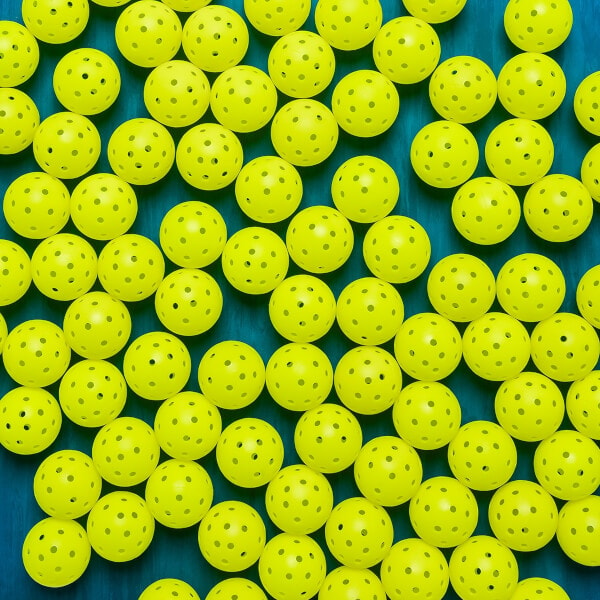
Introduction
Pickleball is one of the fastest-growing sports in the US and around the world, and the specialized pickleball ball is a key part of the game. As pickleball rapidly develops as a sport, the industry is dedicated to advancing the game through innovation and quality for players and tournaments alike. Pickleballs are lightweight hollow plastic balls (similar in appearance to wiffle balls) with precision-drilled holes. They must meet official size and weight standards – roughly 2.87–2.97 inches in diameter and 0.78–0.935 ounces (22.1–26.5 grams). These strict specifications ensure consistency; for example, USA Pickleball rules state that balls should bounce 30–34 inches when dropped from 78 inches at 70°F. In practice, even small differences in weight, hardness, or hole design can dramatically change how a ball plays. For example, a lighter ball can be more affected by wind and may play slower, especially in outdoor conditions.
Pickleball is played with specialized lightweight plastic balls (shown above with paddles on a court). As Pickleheads notes, “Pickleball balls have a big impact on your game. They can play fast or slow, hard or soft, and bouncy or flat.” When a ball plays fast, it offers quicker feedback and is often preferred by players who want a more responsive game. It’s important to choose balls that deliver consistent flight and durability. Using the wrong ball can make the game unpredictable or end the ball’s life too soon. This guide will explore everything about pickleball balls – from technical specs and types to top models, comparisons, and community tips. Whether you’re a beginner or a pro, you’ll learn how to pick the best balls for your play style and conditions. We started playing pickleball several years ago, giving us firsthand experience to help you make the best choice.
Why Pickleball Balls Matter
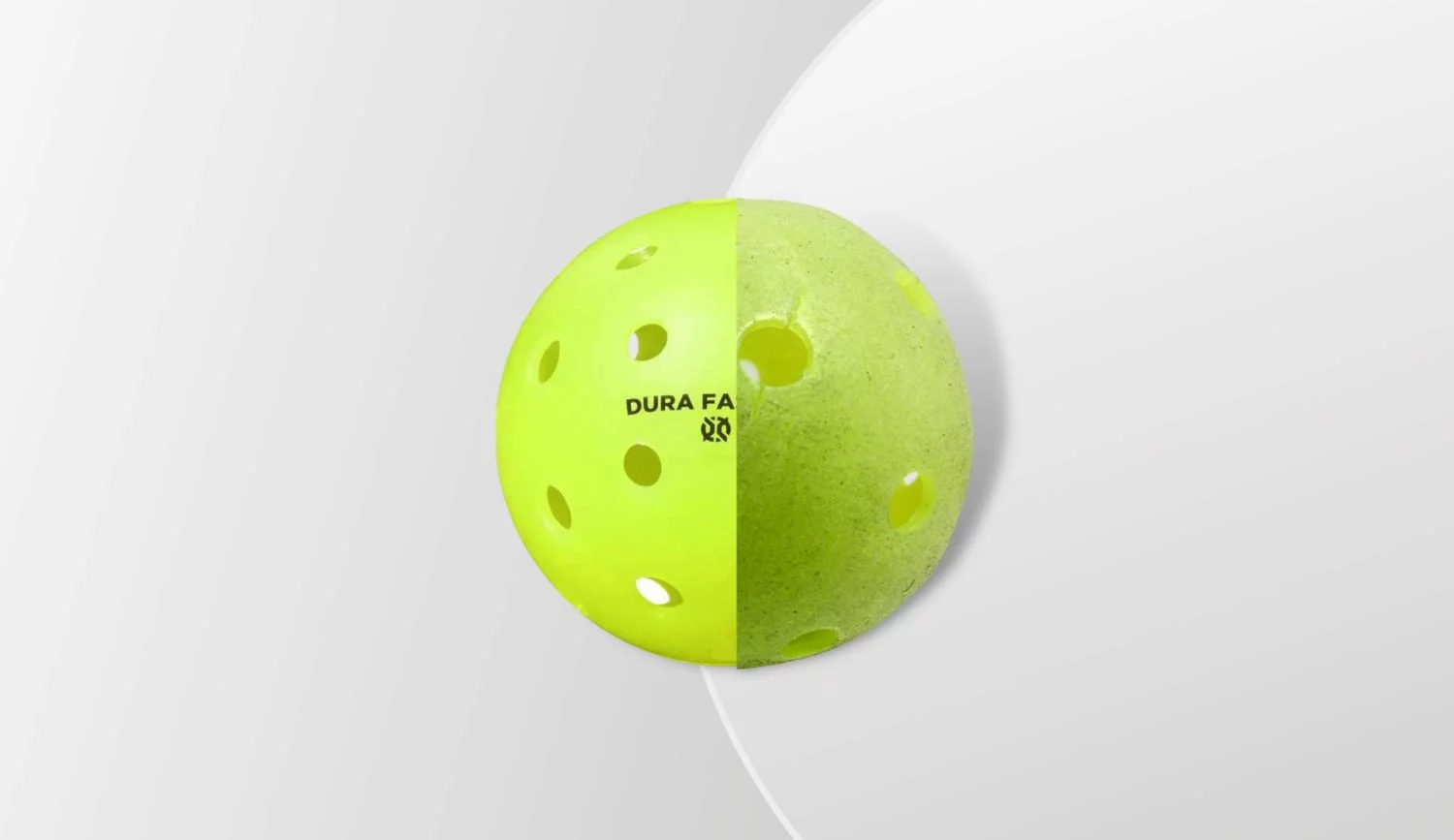
Pickleball balls may look simple, but they can make or break a match. The right ball can enhance your control, give better spin and speed, and reduce unexpected behavior. Conversely, a ball that’s too soft or worn-out can bounce erratically or crack mid-game, ruining rallies. For example, a ball used indoors on wood courts may skip or slide (as one player noted, it’s almost “unplayable” on glossy gym floors). In outdoor play, wind and rough courts demand balls with tougher construction. The consensus among experts is clear: a consistent, high-quality ball is essential for reliable play.
Using a subpar ball can be frustrating. Pickleheads warns that you need something “consistent and won’t crack after the first few sessions”. Inconsistent balls force players to adjust constantly, hurting focus and performance. Pickleball players at all levels, from casual to competitive, benefit from reliable equipment that matches their skill and playing environment. On the other hand, a premium ball feels predictable and lets skill shine. Many high-level players and coaches even stock up on certified competition balls or use separate practice balls to maintain consistency. In short, choosing the right ball is as crucial as picking the right pickleball paddle for your game. Investing a bit of time to select suitable balls ensures better rallies, enjoyment, and less waste – once you find a ball you like, matches become smooth and the ball’s lifespan is maximized.
Key Features of Pickleball Ball
When shopping for pickleball balls, it helps to know the key features that define their performance. Below are the main characteristics that differentiate balls and affect how they play:
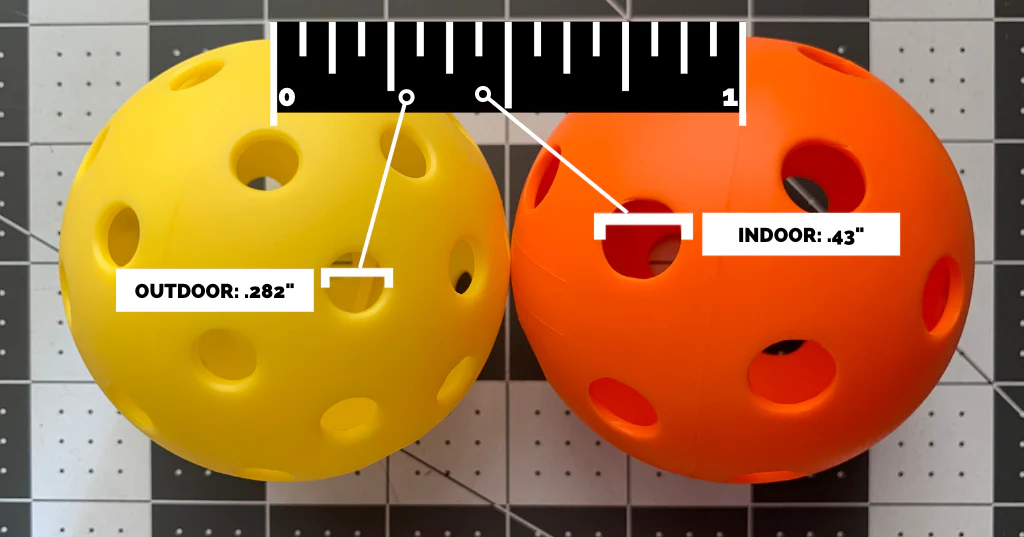
Lightweight balls (even lighter than 22 grams) may feel floaty and play slower, while heavier balls move faster and have a lower trajectory. A lighter ball is more susceptible to wind outdoors and can be preferable for indoor play where wind is not a factor.
Hole Pattern and Precision
The number, size, and arrangement of holes in a pickleball ball directly impact its flight and stability. Outdoor balls typically have 40 smaller holes, while indoor balls have 26 larger holes. The precision of the hole pattern ensures consistent aerodynamics and predictable ball movement. Some brands use a patented design for their hole patterns to enhance flight stability and overall performance.
Bounce and Hardness
Manufacturers measure bounce by dropping the ball from a specific height and recording how high it rebounds. Bounce height is a key factor in ball selection, as it affects shot accuracy and consistency during play. The hardness of the ball also influences how it bounces and feels on the paddle.
Size and Weight Standards
Pickleballs must comply with official size and weight specifications for tournament play. According to USA Pickleball regulations, the diameter of a pickleball shall be 2.87 to 2.97 inches. The ball's weight must be 0.78 to 0.935 ounces(22.1–26.5 grams). These tight tolerances (roughly a quarter-pound difference) ensure that competition balls from different brands behave similarly. Most outdoor balls weigh around 26 grams (0.92 oz), which is near the upper limit, while indoor balls tend to be slightly lighter (often around 24 g).
Balls outside these specs are not allowed in sanctioned events. In practice, recreational balls should also follow them for consistency. Lightweight balls (even lighter than 22 grams) may feel floaty and play slower, while heavier balls move faster and have a lower trajectory. The weight also affects wind resistance – heavier balls cut through wind better. When comparing products, check the listed weight. Many manufacturers post specs (e.g. “26 g” or “0.92 oz”) on packaging.
Hole Count and Pattern
The holes in a pickleball serve a critical purpose: they reduce air drag and stabilize flight. USA Pickleball rules state that balls must have 26 to 40 holes. In practice, outdoor balls almost always use 40 holes, while indoor balls use 26 holes. There are exceptions (like Selkirk’s 38-hole design), but this 26/40 split is standard. More holes generally means more drag and slower speed, while fewer holes means a slightly faster, more unpredictable flight.
The pattern and precision of the holes can also affect play. High-quality balls have uniformly sized, well-drilled holes arranged in a consistent pattern. Cheaper balls sometimes show irregular holes or seams, which can cause wobbling. Some brands (like ONIX) even use two different hole sizes on the ball to tweak aerodynamics. When comparing brands, consider hole count and uniformity. For instance, the Franklin X-40 and ONIX Dura Fast 40 each have 40 precisely drilled holes optimized for outdoor play. Conversely, the GAMMA Photon indoor ball has 26 holes and a two-piece welded construction to control bounce indoor.
Bounce and Hardness
Pickleballs are rated by their bounce, and official standards require a bounce of 30–34 inches when dropped from 78 inches at 70°F. In practical terms, a “good” ball should bounce between 30 and 34 inches. Balls that bounce significantly higher or lower could be non-regulation (e.g. some practice balls or wiffle balls). Bounce is closely tied to ball hardness. A harder ball (still within spec) will rebound more and maintain pace; a softer ball will bounce less and die quickly. Regulation balls are all fairly hard, but variations exist. Some indoor balls (for example, softer practice balls) have lower bounce.
Manufacturers often measure bounce by dropping from a set height onto concrete, then measuring how high it springs back. You’ll see these figures in reviews or spec sheets (e.g. ONIX Dura Fast 40 reports a bounce of about 32 inches from a 75″ drop). Over time, balls soften with use and will bounce lower, which is a sign to replace them in serious play. When testing balls (especially new vs. used), pay attention to bounce consistency – premium balls tend to stay in spec longer.
Materials and Colors
The majority of modern pickleballs are made from durable polypropylene (PP) plastic. This material provides a good balance of stiffness and resilience for outdoor conditions. Some brands highlight special blends: for instance, CORE Outdoor balls use a proprietary urethane mix claimed to be “five times stronger” than typical PP. Other balls like the Selkirk Pro S1 are made with seamless rotomolding technology, which significantly improves durability. Indoor balls often use slightly softer PP or similar plastics to reduce bounce and wear on gym floors; for example, GAMMA’s Photon indoor ball is made with a two-piece welded construction specifically for indoor play.
Pickleballs come in bright colors for visibility. Common high-visibility colors are neon yellow, green, orange, and pink. Indoor balls are almost always bright yellow (to contrast with floors), while outdoor balls may offer multiple color options (neon green, orange, yellow, or even red). Some players have strong color preferences; for instance, one Redditor noted that the Wilson Tru 32 Pro balls only come in a neon “infrared” color, which others find off-putting even though the ball performs well. In general, choose a color that’s easy for you to see against the court surface (dark courts favor neon yellow, light wood courts might favor green). Remember that as the ball ages, the color may fade, but the functionality remains unless the ball cracks.
Types of Pickleball Balls
Pickleballs fall into broad categories based on where and how they are used. Understanding these types helps you pick the ball suited to your needs.
There are also many other brands and styles available, each offering unique features for different playing conditions and preferences.
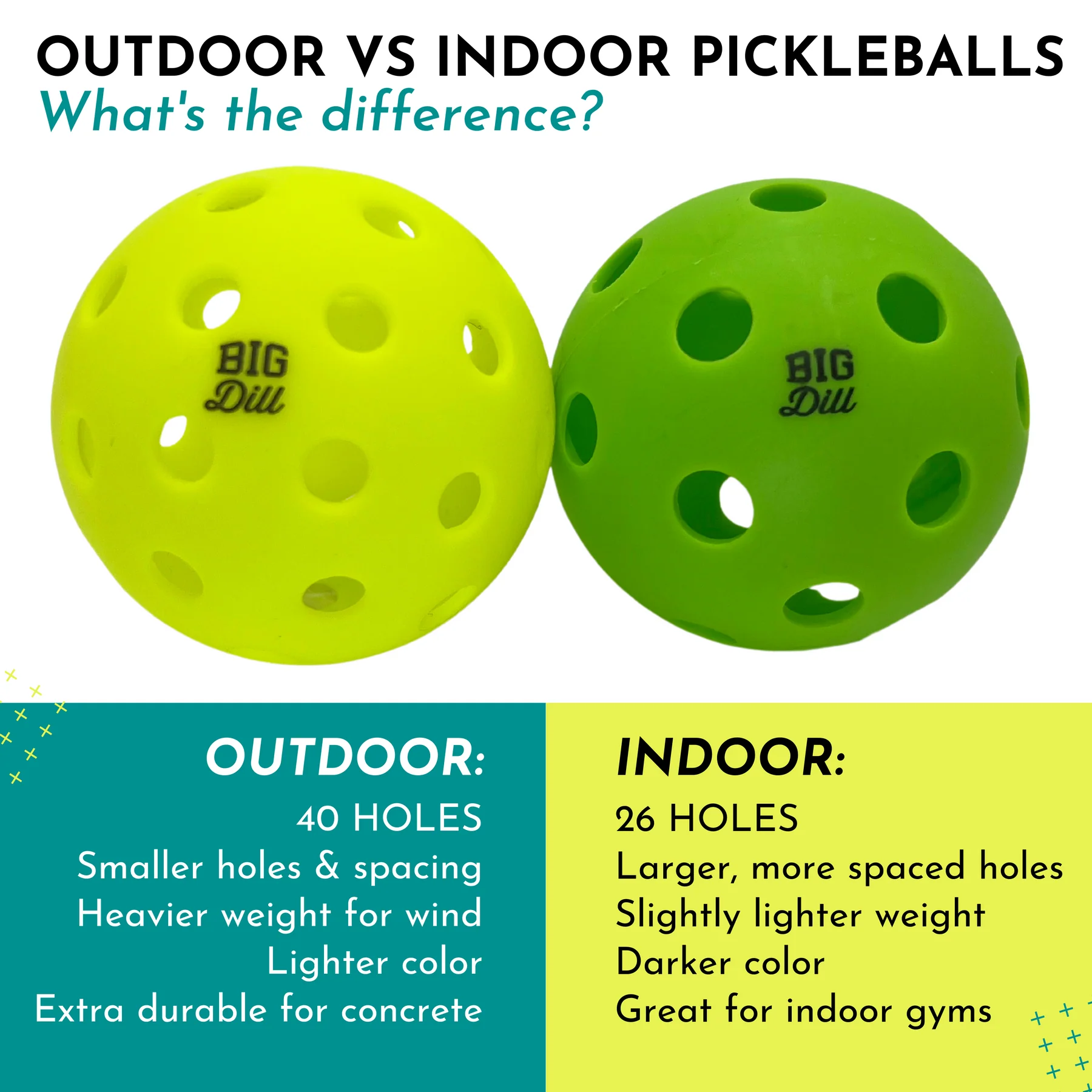
Outdoor Pickleball Balls
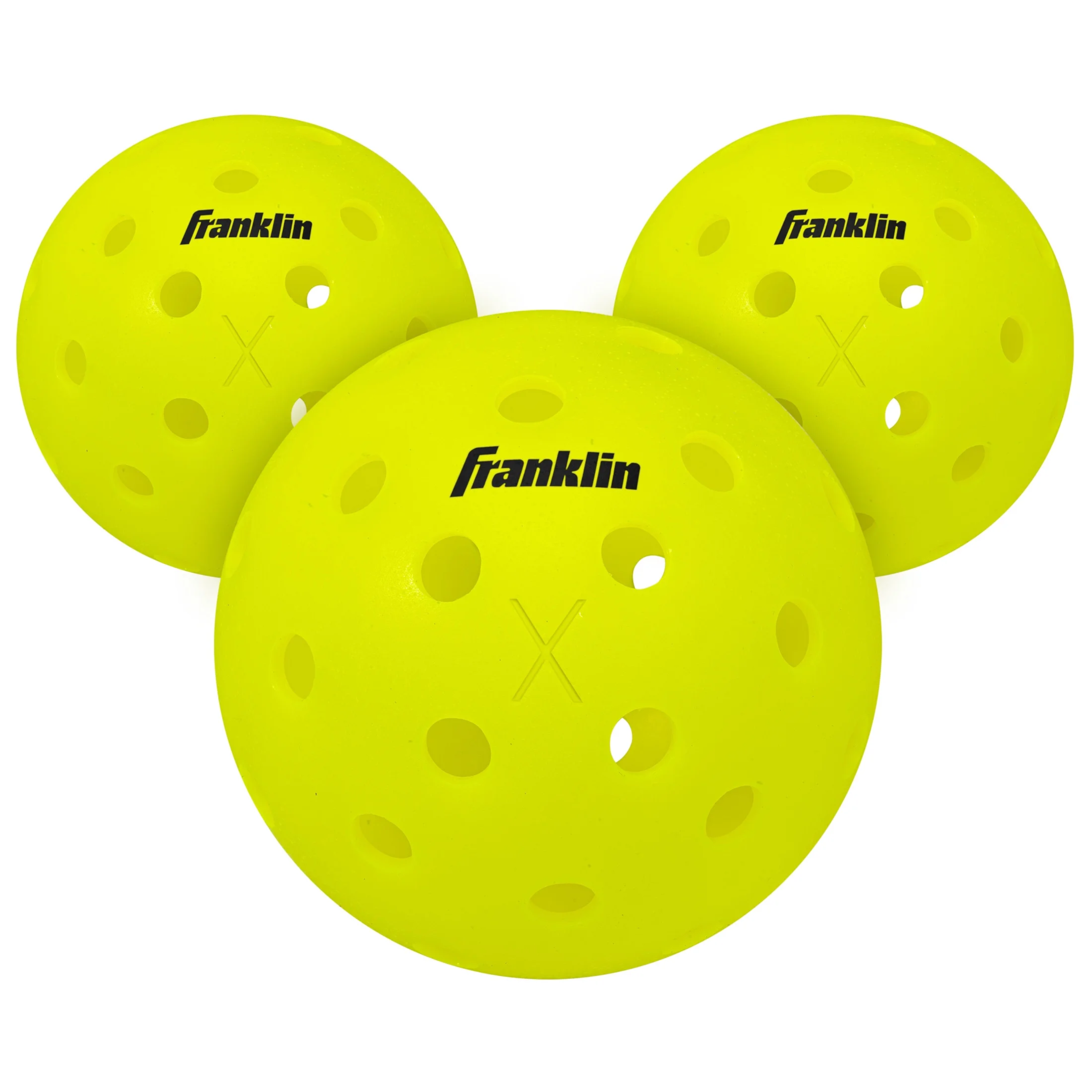
Outdoor pickleball balls are designed for play on hard, often rough outdoor courts. They are usually harder and heavierthan indoor balls, and they have 40 holes. The extra holes reduce wind resistance, but the balls are still built to withstand the elements. As NetWorldSports explains, outdoor balls “tend to be slightly heavier and harder, with smaller holes,” so they aren’t as affected by wind. In practice, top outdoor balls like Franklin X-40, ONIX Dura Fast 40, CORE Outdoor, and Selkirk Pro S1 all use 40 holes and weigh about 26 g.
Because outdoor courts can be windy or abrasive, durability is key. Outdoor balls should endure temperature changes, debris, and hard court surfaces. For example, the Franklin X-40 has a tough one-piece rotationally molded construction specifically for outdoor use. Many outdoor balls (X-40, Dura, CORE) also come in multi-pack boxes or bulk packages since outdoor play tends to “eat up” balls faster. Be aware that outdoor balls often crack if they get too cold – most outdoor balls are made of fairly rigid plastic. Some outdoor pickleballs crack easily in harsh conditions, while others are designed to withstand wind and maintain performance. As one player noted, the ONIX Dura Fast 40 and even the CORE Outdoor can crack in cold weather, whereas balls like the Selkirk Pro S1 hold up at much lower temps. We’ll cover temperature effects in more detail later.
Indoor Pickleball Balls
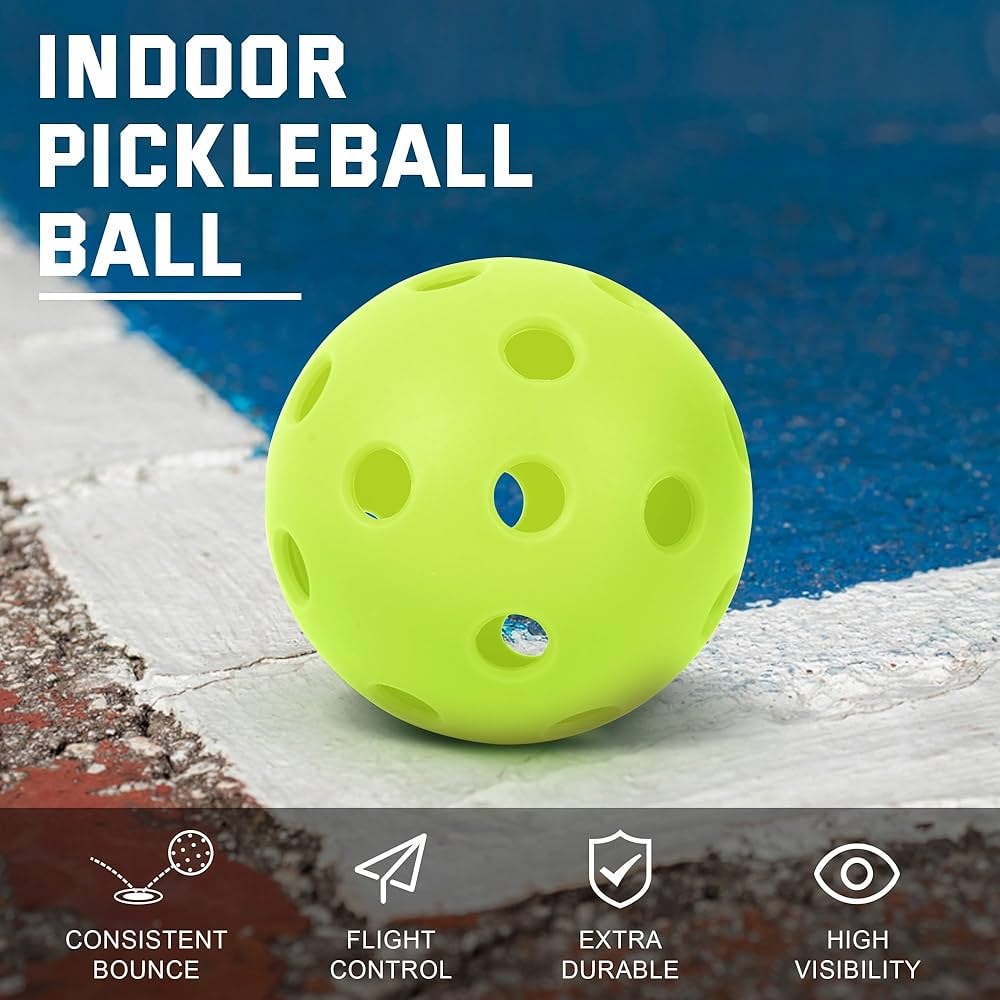
Indoor pickleball balls are optimized for indoor court play (gym floors, indoor courts). They typically have 26 holesinstead of 40. The smaller number of holes makes the ball slightly faster and more lively (because of less drag), and they often have a slightly softer feel. Indoor balls are also usually softer and lighter – for example, many indoor balls weigh around 24 g (vs. ~26 g for outdoors). Some players prefer softer balls for a gentler impact and a more controlled play experience.
Because gym floors are smoother and often out of wood, indoor balls emphasize visibility and floor protection. They are almost always bright yellow to contrast with any surface. Notable indoor balls include the GAMMA Photon (26 holes, high-vis yellow) and various others like the Onix Fuse or JOOLA Prime Indoor. Gamma balls are known for their durability and consistency in indoor play. Indoor balls also wear differently – they may scuff more on hardwood and sometimes split if dragged. A good indoor ball should withstand aggressive play but remain softer to reduce noise. Pickleheads ranks the GAMMA Photon as “the best indoor ball” thanks to its higher durability and speed compared to typical indoor balls.
It’s possible to use an indoor ball outdoors (and vice versa), but it’s not ideal. For example, using an indoor 26-hole ball outside can make the ball fly erratically in wind. Conversely, using a heavy outdoor ball on hardwood may create too much bounce and be tough on the floor. Indoor balls tend to bounce higher on hard surfaces like concrete or wood, but may not perform as well on rubber surfaces. In casual play, some mix-and-match occurs, but competitive players usually stick to dedicated indoor or outdoor balls.
Tournament vs Recreational Balls
Pickleballs also differ by play level. Generally, professional or tournament balls are engineered for elite play: they offer the highest durability, the most consistent flight, and minimal deformation. For example, many “pro” balls come with a no-crack warranty (like the Selkirk Pro S1) and use special manufacturing (rotomolding or hybrid materials) for performance. The Selkirk Pro S1 is a prime example: it has a unique 38-hole pattern and is marketed as “un-crackable,” making it the “indestructible pickleball” many serious players trust. Experienced players are always looking for the best ball for tournament play, prioritizing durability and consistent bounce to ensure optimal performance in competitive settings. An advanced player, especially those participating in high-level tournaments, typically seeks out these high-performance balls for their superior speed, durability, and playability.
Competition (or tournament) balls are a step below pro-grade but still high quality. They are usually the officially approved balls for leagues or national tournaments. For instance, the ONIX Dura Fast 40 was the USA Pickleball Nationals ball, and the Vulcan VPRO FLIGHT Gen2 is the official ball of the PPA and Major League Pickleball. The APP Tour has also signed exclusive partnerships with certain brands, such as Franklin X-40 and OWL, making these balls the official standard for all APP Tour events. These balls balance performance and cost; they might not last forever, but their consistency is key for competitive play. Many of these balls are also chosen for amateur tournaments because of their reliability and performance, making them a popular choice among players at all levels.
Recreational balls are made for fun play. They are typically softer, have larger holes, and are cheaper. Rec balls are forgiving for beginners, easier to hit (larger holes can make the ball slower), and less precise. However, they might not last long under heavy play. The Selkirk blog notes that rec balls are “ideal for beginners, families, and anyone playing for fun,” since they allow for longer rallies and are cost effective. In most cases, Franklin X-40 or Gamma indoor/outdoor balls serve well for recreational leagues, but multi-pack budget balls (like GoSports GS40 or Niupipo) are popular for bulk recreational use.
Practice or training balls (like wiffle balls or specialty practice balls) exist but are not regulated. A common example in development is the Wiffle pickleball (with fewer, larger holes) or ultra-lite balls. These are only for drill training, and they bounce very differently from real pickleballs. In fact, practicing with a wiffle ball can harm your game; one guide warns that switching from a light wiffle to a heavier pickleball will throw off your timing. It’s best to practice with a ball as close to a regulation ball as possible to build true skill.
How to Choose the Right Pickleball Ball
Selecting the right ball involves matching it to your specific needs: court type, playing style, budget, and conditions. Below are the main factors to consider when choosing pickleball balls.
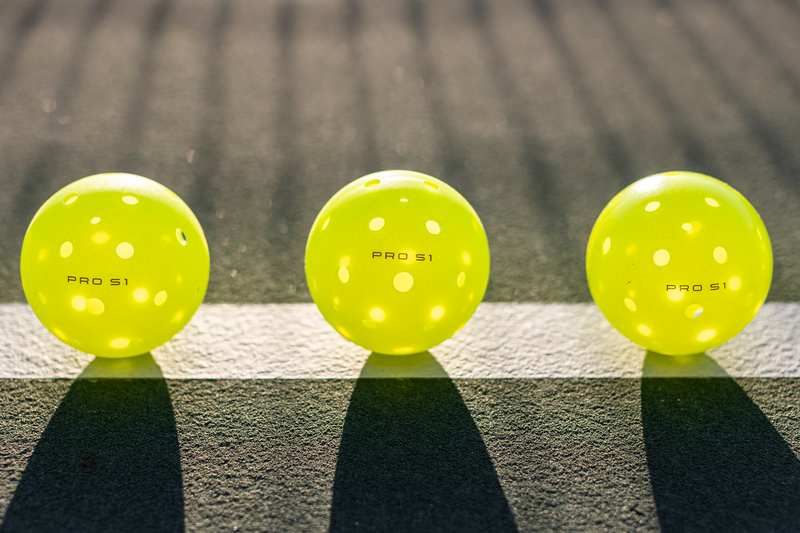
Playing Surface and Environment
Court type is a primary factor. As discussed, choose balls labeled for indoor use if you play in a gym or on wood/poured courts; choose outdoor balls for asphalt or concrete courts. Outdoor balls are built for wind and rough surfaces, while indoor balls are gentler on smooth floors. For example, if you often play in a cold, windy outdoor environment, a durable ball like the Selkirk Pro S1 (which can handle cold as low as 30°F) might be ideal. If you play in an indoor sports center, an indoor-approved ball (like a GAMMA Photon or plain yellow Franklin X-26) is safer.
Weather conditions also matter. In windy conditions, heavier balls (close to 26 g) and more holes (40) will maintain stability. If it’s humid or cold, recall that colder temperatures make the plastic brittle. Many balls crack below 45°F. Some players keep a warm ball in their jacket pockets until each game to avoid cold hardening. One Redditor reported that CORE outdoor balls even cracked in the upper 30s, but Selkirk balls held up much lower. When comparing different brands, some balls last longer or perform better than others under the same conditions. A practical strategy is to switch ball types seasonally: for example, use ONIX Dura Fast 40 in winter and switch back to Franklin X-40 in warmer months. ONIX and Selkirk balls tend to outperform many in cold conditions, while standard balls like Franklin X-40 excel in moderate to warm weather.
Skill Level and Play Style
Your skill level and play style should influence ball choice. Beginners and 3.0-level players usually benefit from slower, more forgiving balls (like Franklin X-40 or generic training balls). These are softer, so slower-paced, allowing for better control and longer rallies. They also last longer under lighter play. Choosing the right ball is important for anyone who wants to play pickleball at their best. Intermediate and advanced players, especially advanced players, often prefer faster, harder balls (like ONIX Dura Fast 40 or Vulcan VPRO) that allow aggressive shot-making. Such players can handle the extra “pop” and require the speed for their style. Hard hitters benefit from balls that can withstand hard shots, as these balls are designed for durability and high-level play. One player noted that ONIX Dura Fast balls are “perfect above 52°F for fast play,” whereas X-40s are better in colder temps.
Consider also what you want to train. If you’re practicing to improve hand speed or preparing for tournaments, a fast ball (Dura or Vulcan) might help. Balls with good spin are preferred by players looking to improve their technique. If you’re playing more socially or in a mixed group, a more neutral ball (X-40 or CORE) provides a balanced experience for everyone’s skill. Clubs often favor Franklin X-40 because it’s durable and consistent across a range of players. Specialized balls like the Selkirk Pro S1 are tailored for “bangers” who smash hard every shot; its durability means it won’t crack under power, but beginners might find it too bouncy.
My recommendations are based on extensive experience playing pickleball over the years, testing different balls and understanding what works best for various skill levels and play styles.
Budget and Use Case
Budget and quantity are practical concerns. Tournament-grade balls (ONIX, Selkirk, Vulcan) can be pricey (often several dollars per ball). Bulk budget balls (like GoSports GS40 or Niupipo) can cost as little as $0.50–$1 per ball in large packs. If you’re a casual player or coach needing many balls for drill machines or lessons, a cheaper ball pack might be fine. The GoSports GS40, for example, provides USA Pickleball-approved quality at about half the price of high-end balls. The trade-off is durability: budget balls tend to crack or warp sooner. Coaches and clubs often buy in bulk (36 to 100 packs) of these affordable balls for open play or drills.
If you’re playing competitively or want the best feel, investing in premium balls is worth it. Middle-ground options include CORE Outdoor (midpriced with high durability) or Gamma Photon (good indoor ball at a reasonable cost). Always compare price per ball: on sale, even expensive balls like Vulcan or Selkirk can drop into a few dollars per ball in larger packs. Watch for deal promotions (Pickleball Central often offers discounts) or affiliates that provide coupon codes. In summary, define how many balls you need and how long you need them to last. For casual use, value packs are ideal; for serious play, splurge on high-performance balls.
Ball Certification and Quality
For competitive play and consistent performance, look for USAPA/USA Pickleball-approved balls. These balls have passed official testing for weight, bounce, hardness, and durability. Approved balls carry the USA Pickleball seal (on packaging). Using a certified ball ensures it meets the standards noted earlier. Practicing with an unapproved ball can mislead your development. For instance, training with a wiffle or other non-regulation ball can ruin your feel; as one guide warns, switching to a real pickleball (heavier and different bounce) could leave you under-hitting shots unexpectedly.
Most major brands produce approved balls. For example, Franklin X-40, ONIX Dura, Vulcan VPRO, Selkirk Pro S1, and many others are all USAPA-approved. Check product descriptions or the official approved ball list (equipment.usapickleball.org) to verify. Notably, the official approval list is updated often: in 2025 alone, balls from JOOLA, Cyclotron, Li Ning and others were newly certified. This growing list shows innovation, but for casual players it mainly means that well-known brands are safe bets. If a low-cost ball doesn’t explicitly state approval, assume it might have slightly different specs. In short, for a regulated game or to train properly, prioritize USAPA-approved balls.
Temperature and Durability
Temperature dramatically affects pickleballs. In cold weather (below about 45°F), plastic becomes brittle. Most balls will crack faster in cold, shortening lifespan. Community feedback highlights this: ONIX and Selkirk balls cope better in cold than others, while some brands (like CORE or cheap balls) crack even in the upper 30's. It’s common to rotate ball choice with seasons: as mentioned earlier, many players use ONIX in winter and Franklin X-40 in summer. Always store balls at moderate temperatures if possible. If you have to play in the cold, try warming balls beforehand (keep them in a pocket or jacket) and replace them when they get too hard.
Durability is also key. A more durable ball resists cracking and warping. Selkirk Pro S1 stands out here: countless players report not cracking even after long play. CORE Outdoor balls claim five times the toughness of average balls. In contrast, standard balls like ONIX Dura or Franklin X-40 will eventually crack under extreme play (especially in the cold). When in doubt, consider customer reviews and user reports. Reddit threads and product reviews often mention how many hours or games a ball lasts. If durability is a priority (for example, if you play outdoors often or toss many balls in practice machines), lean toward the high-end durable models and avoid the cheapest imports.
Top Pickleball Ball Models and Reviews
Below we review the top pickleball balls on the market. This section includes all major balls highlighted by experts and players, including those listed by Pickleheads (Best overall, for speed, etc.) and other community favorites. We cover their features, pros and cons, and who should consider each. Image links are included for visualization.
Franklin X-40 Outdoor
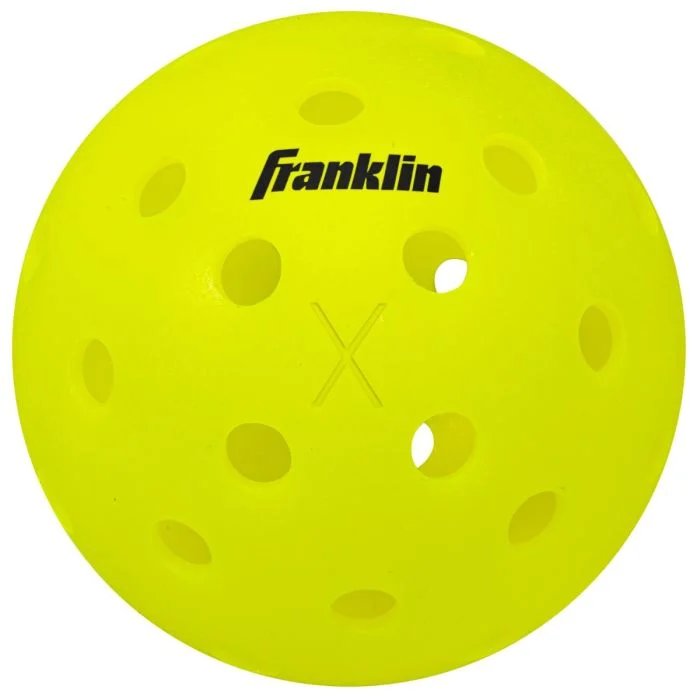
Overview: The Franklin X-40 is often called the “gold standard” of outdoor balls. It has 40 holes, weighs about 0.92 oz (26g) and is USA Pickleball-approved. It’s the official ball of the US Open Pickleball championships and has been the go-to ball for rec players and pros alike. Pickleheads gave it a near-perfect score, praising its consistency across skill levels. It plays moderately fast (score 8/10 speed) with 9/10 durability and 10/10 bounce.
Who it suits: Anyone from beginners to high-level players. The X-40 is rugged and reliable; it holds up on rough outdoor courts and doesn’t spin unpredictably. As one review notes, these balls will “suit anyone who plays pickleball out in the elements”. Clubs love them because they last long and are consistent. The Franklin X-40 is also the official tour ball of the APP Tour, making it the standard for major tournaments and further highlighting its endorsement at the highest levels of play. The only downsides: they can be on the slower side and may crack eventually in very cold weather (below ~45°F). If you need a faster ball or you mostly play indoors, consider others.
Features: One-piece rotationally molded design, 40 precision-drilled holes, smooth surface with a small “X” molded logo on each ball. The bounce is right at regulation (~32″ from 75″ drop). Available in bright yellow, orange, and green, all highly visible. Sold in 3-, 6-, 12-, and 100-count packs (the 100-pack is popular for clubs). It’s mid-priced (roughly $11–$13 per 3-pack) and widely available. Overall, it’s a top-value all-rounder that matches Pickleheads’ “best overall” pick.
ONIX Dura Fast 40
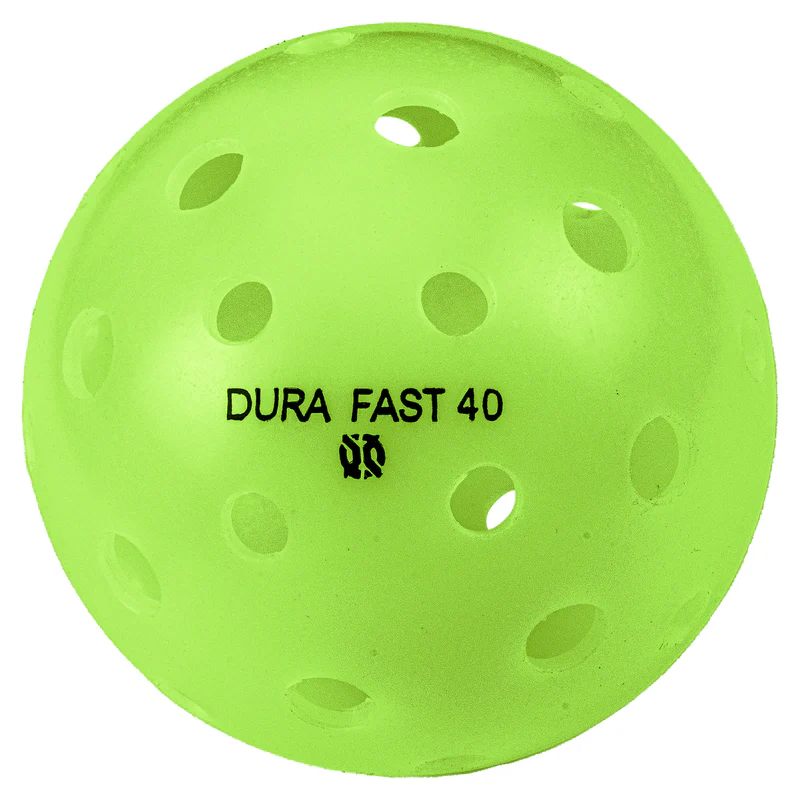
Overview: The ONIX Dura Fast 40 is known for speed and performance. It, too, has 40 holes and weighs ~26g, but it’s constructed slightly harder than the X-40. It’s often chosen by advanced players. Notably, it was the official ball of the USA Pickleball Association National championships. It earned top marks for speed (9/10) though a bit lower durability (6/10) due to hardness. Players describe it as a “rocket” – it flies true with a very flat trajectory. The ball plays fast, offering immediate feedback and quick reactions, which is especially valued in competitive play.
Who it suits: Advanced players and tournaments. This ball’s fast, low flight makes it ideal for high-paced, competitive play. If you’re practicing for tournaments or like aggressive drives, the Dura Fast 40 is a great fit. It’s less forgiving for casual or indoor play: beginners often find it too speedy and hard, and it can be tough to control below a certain skill level. Also, as Pickleheads notes, it will crack faster than some balls, especially in cold or with very heavy hitter. Its outdoor-only design and harder plastic make it less durable in cold than some alternatives.
Features: One-piece seamless construction with 40 drilled holes, weight ~0.92 oz. Comes in neon green or yellow. The USAPA specs show a bounce ~32″. It is USAPA-approved and PPA-sanctioned. Onix designed it as the first dedicated pickleball ball years ago, so many tournament players are very familiar with its “pop.” It’s a pricier ball (often ~$24 for a 6-pack) but current deals and bulk packs reduce cost. In summary, the Dura Fast 40 delivers unmatched speed and consistency in flight (worth its 9/10 ratings), but trade off some durability and value.
CORE Outdoor
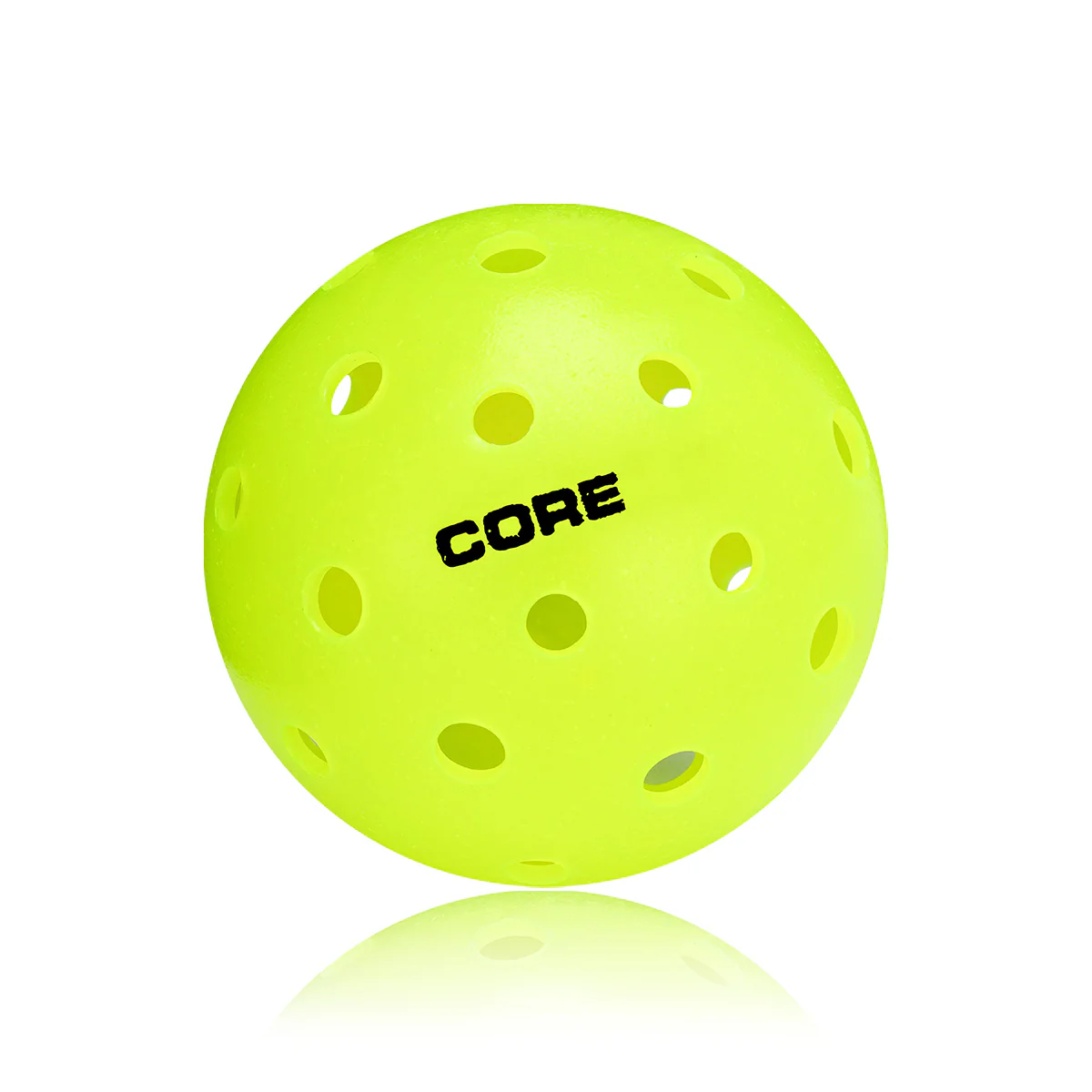
Overview: The CORE Outdoor ball is built for durability and outdoor stability. It has a standard 40-hole design and maximum allowable weight (0.92 oz) for a heavy feel. CORE claims these balls are “five times stronger” than typical balls due to a special urethane blend. In testing, Pickleheads found the CORE has a very consistent bounce (31.73″) and holds up well even in wind and rain. It scored 9/10 in durability and 9/10 overall.
Who it suits: Outdoor players who want a tough ball. If you play in windy or rough conditions, this ball helps your shots fly true. Aggressive hitters (“bangers”) will appreciate that CORE balls stand up to hard smashes without cracking quickly. It’s also good for intermediate/advanced players who want a fast ball (8/10 speed) that is still a bit easier to control than the ONIX or Vulcan fast balls. However, it’s not the best cold-weather ball; CORE balls are known to crack more easily under 45°F, so consider Selkirk if you play in chilly conditions. Casual players might also find the CORE a bit faster and stiffer than needed – Franklin X-40 is slower and more comfortable for beginners.
Features: CORE balls are seamless with 40 holes and the heaviest allowable weight. The patented formula makes them noticeably harder; one tester said shots “go where I aim them—even in a little crosswind.” The bounce is very consistent, matching X-40 speed-wise. They come in neon green (lurid color) and are USAPA-approved. CORE typically sells in multipacks (e.g. 6-packs or bulk boxes). They are mid-priced (similar to X-40), but often on sale or with bulk discounts. In short, CORE Outdoor is an excellent choice for serious outdoor play, combining the reliability of Franklin balls with extra toughness.
Selkirk Pro S1
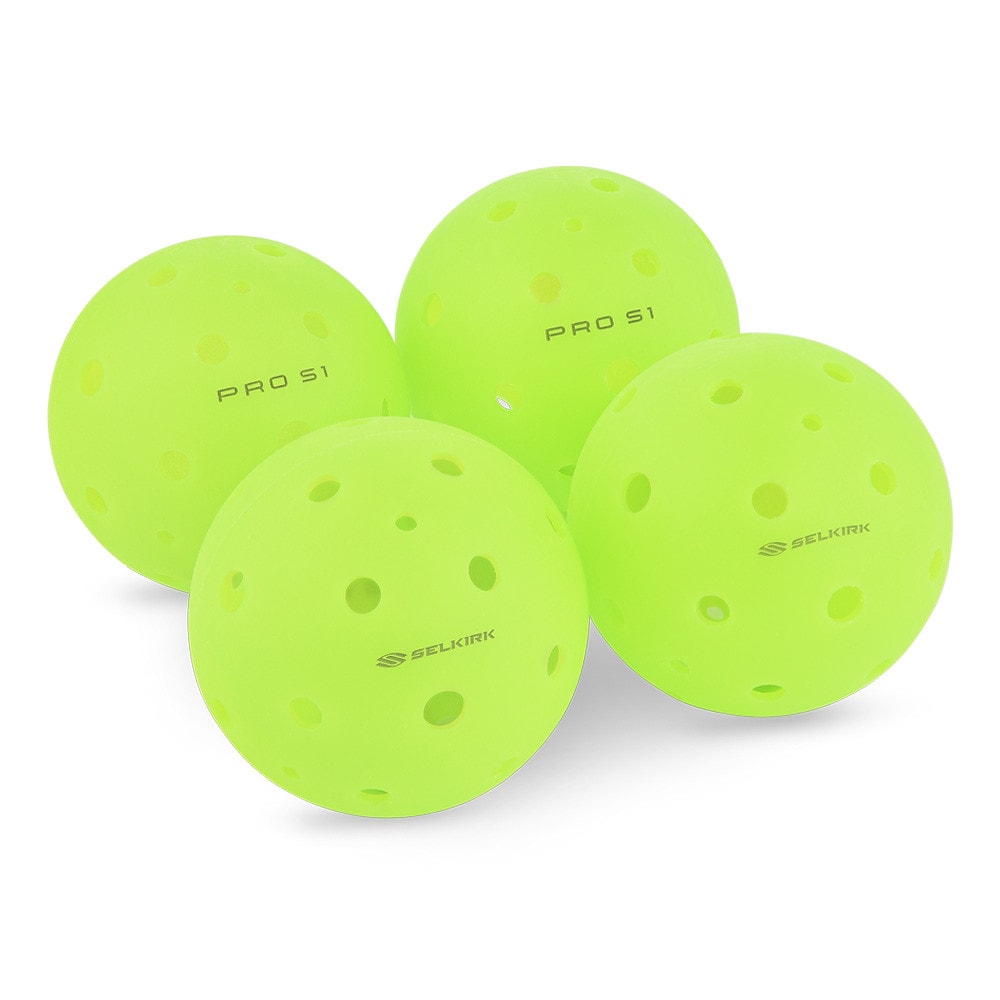
Overview: The Selkirk Pro S1 is the “indestructible” ball on the market. Its 38-hole, seamless rotomolded construction is engineered for maximal durability. Pickleheads gave it a 10/10 durability rating. In real-world tests, even four hard-hitting players couldn’t break one in 3 hours. It also performs very well on cold courts – players report it can withstand 30°F conditions without cracking.
Who it suits: Power hitters and cold-weather players. If you hate cracking balls, the S1 is your top pick. Bangers will relish that they can smash all game without a pile of broken balls afterwards. Even in winter play, this ball stays intact when almost all others fail. However, the Pro S1 is also relatively fast and “poppy.” It scored 9/10 speed and 8/10 bounce, making it higher-lob and faster-moving than a Franklin ball. Beginners may find it too lively – one Pickleheads review warns that newbies might prefer a slower ball, and indoor players should get a Gamma Photon instead. Also note: the S1 comes in a very bright neon green only, not multiple colors.
Features: 38 precision-drilled holes, 0.93 oz weight, and a slightly smaller diameter (2.8″ vs ~2.9″ for 40-hole balls). Its holes are spaced to improve aerodynamics and strength. The ball has a smooth, hard surface. Available only from Selkirk (they sometimes bundle with paddles). It’s premium-priced – the Pro S1 can cost around $20–$25 for a 3-pack. The brand markets it as a revolutionary no-crack ball, and many reviewers affirm its longevity. In summary, if durability is your top concern and you don’t mind a faster, harder ball, the Selkirk Pro S1 is unmatched.
GoSports GS40
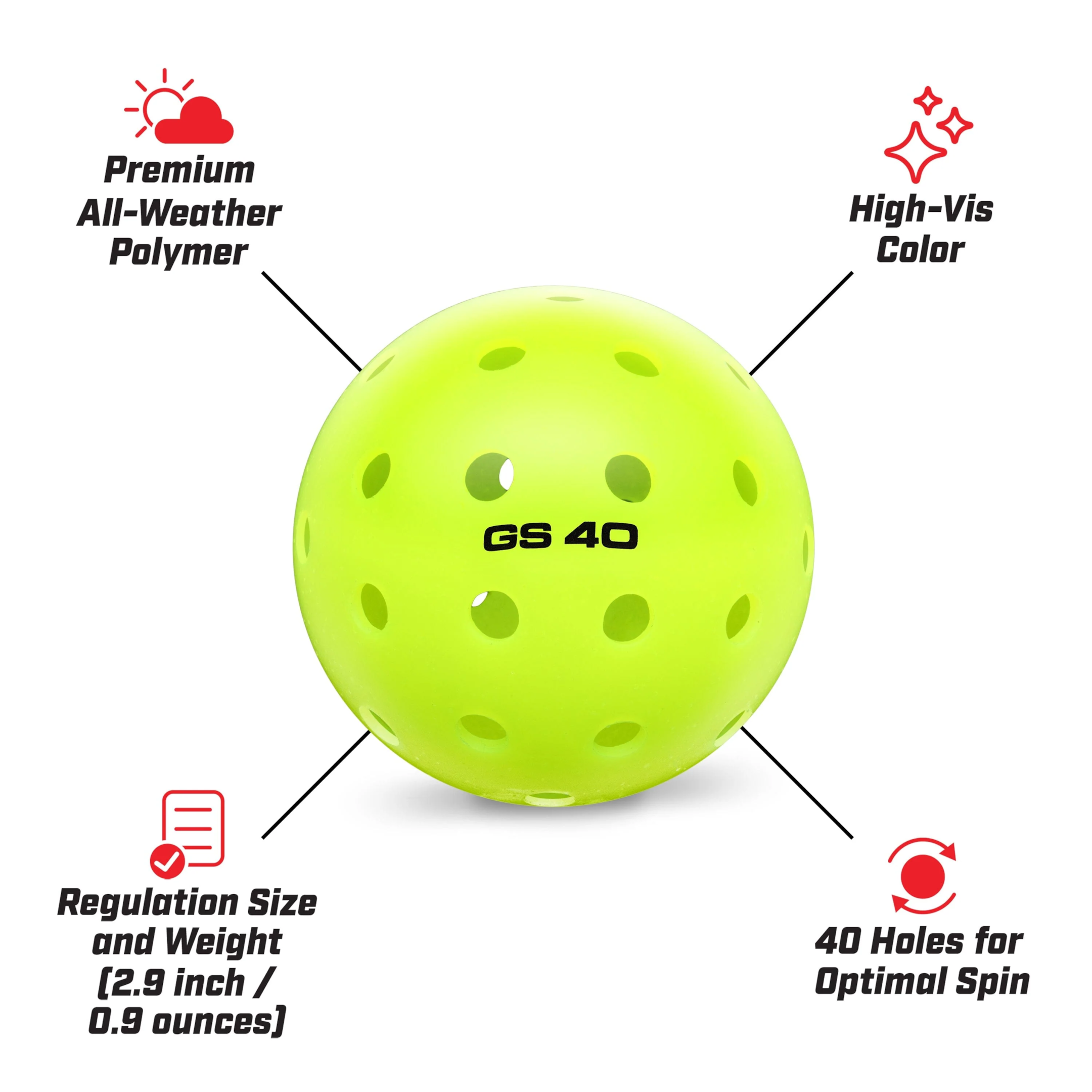
Overview: The GoSports GS40 is a budget-friendly outdoor ball that offers USA Pickleball approval at a very low cost. Each ball weighs ~0.9 oz (25.5g) with 40 holes. Pickleheads gave it average ratings (7/10 durability, 6.5/10 speed). Its main appeal is value. You can often find 36-packs or larger of GS40 balls for under $1 per ball on sale.
Who it suits: Casual players, clubs, or coaches needing lots of balls on a budget. For pick-up games, practice machines, or community courts, GS40 provides decent playability at half the price of top-tier balls. Reviews say GS40s play very similarly to Franklin X-40s (“very closely to the X-40s”) despite costing much less. They are fine for recreational and intermediate use. Advanced tournament players may prefer something faster (they often skip GS40s), but for everyday play, GS40 is a solid value. The GS40 is a lighter ball, which some players may prefer for its softer feel, but it can be more affected by wind during outdoor play.
Features: Standard one-piece construction with 40 uniform holes, weight 0.9 oz. Bright neon green color. It’s USAPA-approved for official play. The bounce meets spec. It’s typically sold in multi-balls packs (12, 18, 36, etc.). According to Pickleheads, these balls are “great value for money” – you can get six balls for roughly $6–$8, so about $1 each. That cost-effectiveness makes them popular for bulk needs. Note: because GS40s are lighter than some high-end balls, players report they don’t perform quite as well in very windy conditions and they may crack sooner than premium balls if hit extremely hard. Nonetheless, for most players on a budget, the trade-off is acceptable.
Vulcan VPRO FLIGHT (Gen 2)
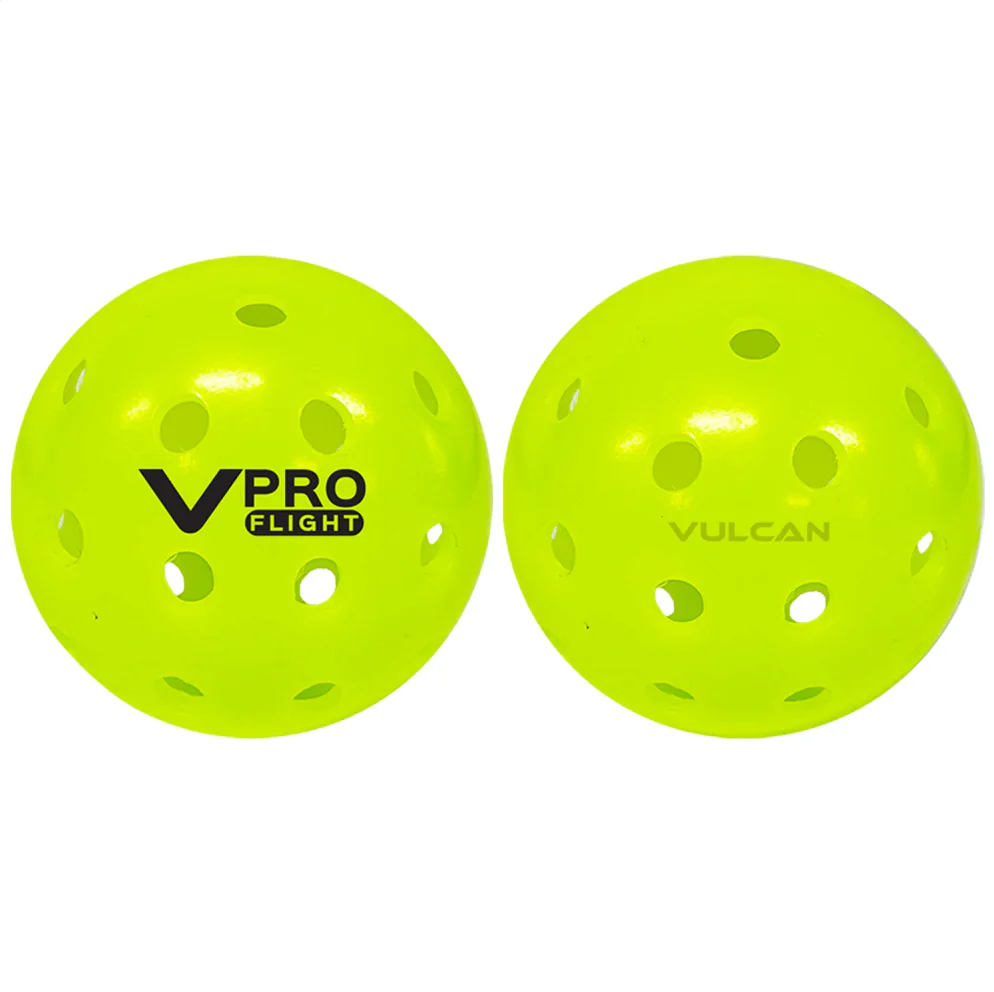
Overview: The Vulcan VPRO FLIGHT Gen 2 is the official ball of PPA and Major League Pickleball events. The vulcan ball is known for its high manufacturing quality, consistent performance characteristics, and strong durability, making it a top choice for both tournament and recreational play. It’s engineered for high-end competitive play. The Gen 2 improved on the original with better balance (Vulcan says they fixed lopsidedness issues). It features 40 holes and the maximum weight (0.92 oz). In testing, Vulcan rated high on speed (9/10) and durability (8/10) pickleheads.com. Players call it fast, spin-friendly, and similar in power to the Dura Fast.
Who it suits: Intermediate and advanced players, especially those in tournament settings. The Vulcan VPRO FLIGHT is ideal for the advanced player seeking top performance in high-level or tournament play. If you play in PPA/MLP circuits or want practice with the official tournament ball, get the Vulcan VPRO FLIGHT. It’s designed for a fast, spinny game. Because it is so fast, beginners or recreational players may find it too hard to control. It’s also relatively expensive unless bought in bulk – Vulcan often sells 100-packs which bring the price down to ~$2 per ball, but small packs can cost more. Like other fast balls, it cracks sooner if not in ideal conditions. For durability, Selkirk still wins, but Vulcan has the slight edge over X-40 in toughness (8/10 vs 9/10).
Features: One-piece seamless poly construction with 40 holes, neon green color. Bounce ~33.5″. Officially approved. The Gen 2’s formula yields extra spin on shots. It’s marketed with bulk discounts (with codes often provided for 20% off) because it is expensive per unit. In summary, Vulcan VPRO FLIGHT Gen 2 is a top-tier competition ball for advanced play – lightning-fast with excellent flight consistency. It comes at a premium, but if the PPA Tour or MLP are in your future, this is the ball you’ll see in play.
GAMMA Photon Indoor
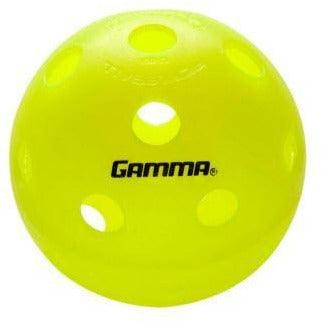
Overview: The GAMMA Photon is a top-rated indoor-specific ball. It is one of the most popular indoor pickleballs for gym and recreation center play. It uses a 26-hole welded construction and weighs about 0.85 oz (24g) for indoor use. Pickleheads calls it the “best indoor ball” because it is stronger and faster than most other indoor balls. The Photon is designed to give a lively feel on wooden courts (almost like an outdoor ball) while still being gym-friendly. Additionally, the GAMMA Photon Indoor Ball plays most like an outdoor ball and is known for its speed and good spin.
Other Notable Balls
Beyond the above, several other balls are popular:
-
Wilson Tru 32 Pro: This is a 32-hole ball (though not USA-approved for competition) known for extreme durability and unique orange color. A Redditor praised its cold-weather performance and round, but notes its color deter players.
-
Wilson Tru 32: A 32-hole recreation ball that’s very soft and slow (great for players under 4.0) and lasts a long time in cold, though it’s more for casual play.
-
Nike Vapor, Niupipo, Gearbox GB27/40, OSO Freestyle: These are budget or practice balls. Niupipo MX-27 (30-hole) plays much like OSO Fury, and Gearbox GB40 (same as CORE) is solid. They offer more affordable alternatives, often in bulk packs. Be aware some of the very cheapest imports (non-branded) may not meet specs or may become out-of-round quickly.
-
JOOLA and Cyclotron: Newer entrants from the USA Pickleball-approved list, including JOOLA Primo Indoor Plus and Cyclotron models. They’re USAPA-approved but haven’t been widely reviewed yet.
-
Prince, PONDO, & Others: A few other USAPA-approved balls exist (Prince outdoor, and some specialty ones). These are less common but represent that many brands are now in the game.
When choosing from less-common brands, read up on community feedback and consider sticking to proven favorites for critical games.
Product Comparison Tables
Comparison of Ball Features
|
Ball |
Holes |
Weight |
Bounce |
Best Use |
Notes |
|---|---|---|---|---|---|
|
Franklin X-40 Outdoor |
40 |
0.92 oz (26g) |
~32″ from 75″ drop |
All-around outdoor & competitive |
Reliable, moderately fast, durable; official US Open ball |
|
ONIX Dura Fast 40 |
40 |
0.92 oz (26g) |
~32″ from 75″ drop |
High-speed outdoor play |
Very fast, flat trajectory; used in national tournaments; considered one of the fastest balls available for outdoor play; cracks more in cold. |
|
CORE Outdoor |
40 |
0.92 oz (26g) |
31.73″ from 75″ drop |
Windy/outdoor play, bangers |
Super durable (CORE claims 5×), consistent in wind. Not ideal < 45°F. |
|
Selkirk Pro S1 |
38 |
0.93 oz (26.4g) |
Not listed |
Extreme durability, outdoor |
Almost unbreakable, lasts in cold; faster & bouncier than x-40. Popper feel. |
|
GoSports GS40 |
40 |
0.90 oz (25.5g) |
Not listed |
Budget outdoor play |
Half the cost of X-40; similar feel to Franklin; less durable for hard use. |
|
Vulcan VPRO FLIGHT |
40 |
0.92 oz (26g) |
33.5″ from 85″ drop |
High-level competition play |
Official PPA/MLP ball; very fast/spinny; expensive unless bulk. |
|
GAMMA Photon (Indoor) |
26 |
0.85 oz (24g) |
33″ from 78″ drop |
Indoor gym play |
Stronger than average indoor ball; high speed for indoor; yellow only. |
Table: Key feature comparison of popular pickleball balls (holes, weight, measured bounce, and best use cases). Bounce heights are as tested by reviewers or manufacturers.
Pros and Cons Summary
-
Franklin X-40 Outdoor: Pros: Very consistent, durable, great for all levels; a great ball for players seeking reliability and consistent performance. Cons: A bit slower, softer feel; not the fastest ball; cracks if used very hard or cold.
-
ONIX Dura Fast 40: Pros: Fastest outdoor ball with consistent flight; official tournament ball. Cons: Harder on the arm, cracks easier (especially below ~50°F), and is more expensive. Requires skill to handle.
-
CORE Outdoor: Pros: Excellent durability (harder urethane mix), consistent even in wind. Cons: Fast and firm; if you prefer a slower ball or you play in very cold weather, it may not be ideal. Color options limited.
-
Selkirk Pro S1: Pros: Unmatched durability – practically indestructible. Handles cold well; good speed and spin. Cons: Very poppy/fast (some find it too much); only neon green; premium price. Beginners may struggle with its lively bounce.
-
GoSports GS40: Pros: Best value; reliable play close to Franklin; sold in bulk for cheap. Cons: Lighter feel; durability is average (more wobbles or cracks than premium balls). Not recommended for elite play.
-
Vulcan VPRO FLIGHT (Gen2): Pros: Designed for high-level play, great spin and speed; official ball of PPA/MLP; new Gen 2 fixed old issues. Cons: Expensive unless in bulk; may crack faster than Selkirk; too fast for novices.
-
GAMMA Photon (Indoor): Pros: Strong, fast indoor ball (plays almost like an outdoor ball) affordable; 26-hole certified design. Cons: Only yellow color; not for outdoor use; others prefer Franklin-style balls for indoor fun play due to color choice.
In general, durability follows roughly: Selkirk ≥ CORE ≈ Vulcan ≥ Franklin ≈ GoSports ≥ ONIX ≥ Gamma (indoors). Speed/flight is: ONIX ≈ Vulcan > CORE ≈ Selkirk > Franklin ≥ GoSports > Gamma. Choose based on what trade-off you need.
Community Insights and Player Tips
The pickleball community has plenty of opinions on balls. Here are some insights from forums and experienced players:
-
Ball Cracking and Weather: Many players note that each brand has a “temperature limit.” For instance, CORE balls can crack in the upper 30s (°F), whereas Selkirk Pro S1 balls last longer in cold conditions. A common complaint among players is that some balls, like the Pro S1s, warp or lose shape quickly, which affects their performance and longevity. One practical tip from players is to swap balls seasonally: use ONIX DuraFast 40 in winter when it’s cold, and switch to Franklin X-40 when it warms up. This matches the fact that X-40s soften (and play better) in cold temperatures, while DuraFast balls need warmer temps to soften a bit. In general, almost all balls will suffer below 40°F, so many cold-weather players either use Selkirks (rated to ~30°F) or simply cover the balls with warm towels between games.
-
Ball Play Characteristics: Players on Reddit often compare X-40 vs DuraFast40. One 4.0+ player explained that DuraFast balls “play faster but don’t last as long,” and maintain a constant feel until they break. He also noted that X-40s are “softer, more durable, and better in cold temps”. Another player commented that Franklin balls slow down (“soften”) as they wear over a day, while DuraFast balls tend to fail (crack) before noticeably slowing down. In short: X-40 = slower, control, longevity; DuraFast = speed, consistency (but higher cost per ball, and more delicate).
-
Bulk Buying: Coaches and clubs emphasize bulk value. Some Reddit users recommend packing anywhere from 36 to 100 balls for practices and tournaments. A club league organizer might buy a 100-pack of Vulcan or Niupipo balls because the price per ball is unbeatable (often around $2 each with discounts). The GoSports 36-pack is popular for local open-play sessions because it’s cheap and playability. On the flip side, advanced teams might keep a handful of brand-new premium balls for official matches.
-
Unexpected Tips: A few community suggestions: avoid mixing brands in a single game (players can feel differences and get thrown off). Also, if playing indoors on a slippery surface, remember that outdoor balls can skip; one player said they’d “rather wall-drill by myself than play a yellow outdoor ball on a glossy wood court”reddit.com. In general, discussions suggest erring on the side of the ball made for the conditions: indoor balls for indoors, outdoor balls for outdoors.
Overall, community consensus is to test a few balls yourself – if friends or club members have favorites, try them. Popular balls like Franklin, ONIX, and Vulcan come up repeatedly in discussions. When buying online, reading recent reviews (and forum comments) can confirm whether a ball still performs as expected.
Maintenance and Care for Pickleball Balls
To maximize ball life and performance, follow some simple maintenance tips:
-
Check Balls Regularly: Before each session, inspect balls for cracks, holes, or warping. A distorted ball will bounce irregularly. Replace any ball that is out-of-round or cracked (even hairline cracks will grow).
-
Rotate Use: If you have many balls, rotate which ones you use in games. This spreads out wear. For example, use some balls for warmups and others for match play.
-
Cleaning: Dirty balls can affect bounce. Clean outdoor balls by rinsing with water and mild soap if needed. Avoid harsh chemicals or alcohol (they can damage the plastic). Indoor balls rarely get very dirty, but you can wipe them with a damp cloth if needed.
-
Storage: Store balls in a cool, dry place away from direct sunlight. Heat can soften or warp the plastic, and UV can cause brittleness. Many players keep balls at room temperature; if you took balls outdoors in winter, bring them back indoors between sessions.
-
Avoid Extreme Temperatures: If balls have been in a hot car or freezing cold, let them acclimate to room temperature before using. Rapid changes can cause warping or cracking.
-
Ball Machines and Drills: If you use a ball machine, use balls designed for machines (they are often slightly harder). Some brands sell “machine pickleballs” that survive firing.
-
Practice vs Match Balls: For longevity, some coaches use cheaper practice balls on machines, and reserve the pricier ones for matches. As one Redditor suggested, a machine holding 150 balls can be expensive to fill, so budget practice balls (like GoSports or Niupipo) are an economical choice.
-
Replacement Frequency: There’s no set rule, but if your balls start feeling dead (bounce too low) or visibly wear, swap them. Players often keep the same ball for weeks if it’s still performing, but replace cracked balls immediately. A good rule of thumb is: if a ball bounces 3–5 inches less than new spec (under 30″ from 78″ drop), it’s time to retire it.
By caring for your balls, you’ll extend their useful life and maintain a better playing experience. Remember that even top-quality balls will eventually wear out; rotating and proper storage can double or triple their lifespan.
Trends and Innovations in Pickleball Balls
The world of pickleball balls is evolving. Here are some recent trends:
-
Material Science: Brands experiment with plastics. For example, CORE claims a special urethane blend that’s tougher than standard polypropylene. Selkirk’s rotomolded design (introduced with the Pro S1) is a breakthrough in durability. Some manufacturers are even touting eco-friendlyplastics. Vermont (a ball producer) says its balls are made of sustainable polypropylene conforming to official rules. This reflects a trend toward more durable and environmentally conscious materials.
-
New Brands: The approved ball list has ballooned. Brands like JOOLA (with its Primo Indoor) and Cyclotron have just entered the scene. Cyclotron offers both indoor and outdoor models (approved in March 2025) and has garnered attention for its unique look. Li Ning (a major racket sports brand) also introduced new balls (PG4 Outdoor). While these are certified, they still need market testing. As a consumer, keep an eye out for new entries – they often come at competitive prices to gain market share.
-
Specialty Balls: Conceptual designs pop up occasionally. For example, there have been novelty “pickle-shaped hole” balls and foam training balls (for beginners). However, most innovation focuses on refining the performance of standard balls. Hybrid balls (midway between indoor/outdoor) or adjustable-durometer balls have been discussed but are not mainstream. One interesting recent entry is Joola’s two-piece indoor ball (competing with Gamma Photon). As indoor play grows, we may see more variety (different colors, patterns).
-
Digital and Training Tech: Though not a ball itself, technology is influencing ball use. Smart ball machines can now track ball wear (estimating “shots until crack”) and dispense balls of different speeds. Meanwhile, brands may produce practice sets with balls of slightly different weights to train feel. While these aren’t widespread consumer products yet, expect more tools that integrate with balls (e.g., ball trackers or sensors).
In summary, expect continued refinement of plastics for durability, more brand options, and perhaps eco-friendly launches. The core dimensions (diameter, hole count) will remain fixed by rules, but how balls are made (one-piece vs two-piece, chemical composition) will keep advancing.
Frequently Asked Questions
Q1: What’s the difference between indoor and outdoor pickleball balls?
A1: The primary differences are hole count and hardness. Outdoor balls have 40 holes, are made of harder/heavier plastic, and are designed for wind and rough courts. Indoor balls have 26 holes and are slightly softer and lighter (about 24g) for smooth gym floors. Using an outdoor ball indoors can skip on the floor, and using an indoor ball outside can be too affected by wind. Always choose the ball type meant for your court surface.
Q2: How long does a pickleball ball last?
A2: It varies. A ball’s life depends on how hard and often you hit it, and on conditions. Recreational play might wear out a cheap ball after a dozen games; a premium ball can last months if used sparingly. Cold temperatures and hard surfaces shorten lifespan. Watch for cracks or wobble – when you get wobbles, that ball’s done. Many players replace balls when bounce drops noticeably (below spec) or when holes crack. High-end balls like Selkirk Pro S1 can last far longer under the same use than a budget ball.
Q3: Why do pickleball balls crack?
A3: Cracks happen due to the brittle plastic shell being stressed. Hitting a ball with full power, especially on concrete or at cold temperatures, can cause hairline cracks. Over time, plastic fatigue from repeated impacts leads to breakage. Cheaper balls often have more impurities in the plastic and crack sooner. To reduce cracking: warm balls before cold weather play, avoid deep cracks by checking after powerful hits, and rotate balls to spread wear.
Q4: Which pickleball ball is best for beginners?
A4: Beginners benefit from a slower, more forgiving ball. Franklin X-40 is often recommended for learners due to its consistency and durability. Some indoor beginners use Wilson Tru 32 (soft 32-hole ball) for its gentle feel (though it’s orange and unapproved). In general, start with any standard USAPA-approved ball (like X-40 or Gamma indoor) rather than novelty balls. As skill grows, you can experiment with faster balls.
Q5: Are more expensive balls always better?
A5: Not necessarily better, but they suit different needs. Expensive balls like Selkirk or Vulcan are engineered for high-end play (exceptional durability or speed). If you need those traits, they’re worth it. For everyday casual play, mid-range balls like Franklin or Gamma often suffice. Budget balls (like GoSports) are fine for practice and bulk use. Evaluate if the benefits (longer life, specific performance) justify the cost for your situation.
Q6: Can I use wiffle balls or tennis balls for pickleball?
A6: No, not for official play. Wiffle balls (even pickle-shaped ones) and tennis balls are not regulation. They bounce and move very differently. As noted above, switching from a lighter wiffle to a regulation ball will likely throw off your timing and power. Use wiffles only for very casual backyard fun or novelty. Always use a proper pickleball when practicing to develop accurate skills.
Q7: How many holes should a pickleball have?
A7: Between 26 and 40 holes, per official rules. Indoor balls use 26 holes, outdoor balls use 40. Rare exceptions exist (the Selkirk Pro S1 uses 38), but any regulation ball falls within that range. The holes should be uniformly sized and distributed. More holes increase drag and slow the ball slightly; fewer holes make it a bit faster.
Q8: What is the official pickleball ball of tournaments?
A8: It depends on the tournament. USA Pickleball Nationals (as of 2024) used the ONIX DuraFast 40. Professional tours have chosen different balls: the Vulcan VPRO FLIGHT Gen2 is the official ball of the PPA Tour and Major League Pickleball. The Franklin X-40 is the official ball of the US Open Pickleball championships. Local tournaments often pick one of these approved brands. If you plan to enter events, it’s wise to practice with the same ball used there.
Q9: How does hole count affect the game?
A9: Hole count (and pattern) affects flight and feel. A 26-hole ball (indoor) generally flies faster with a slightly higher bounce, suiting quick indoor rallies. A 40-hole ball (outdoor) has more drag and a more predictable, stable flight in wind. In practice, a 26-hole ball (indoors) will come at you a bit quicker, while a 40-hole ball (outdoors) may drop faster. Players who want extra spin sometimes use 38-hole balls like the Pro S1 for a unique feel. Ultimately, 26 vs 40 is mostly about indoor vs outdoor use.
If you have more questions about pickleball balls or related gear, feel free to explore our other guides (for example, [Pickleball Paddles] or [Pickleball Equipment]) or contact our experts. We hope this guide helps you confidently choose and enjoy the best pickleball balls for your game!



Leave a comment
All comments are moderated before being published.
This site is protected by hCaptcha and the hCaptcha Privacy Policy and Terms of Service apply.